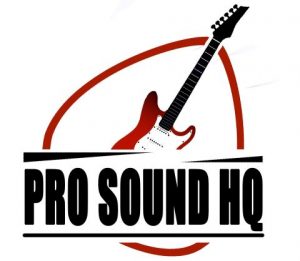Using some guitar effects pedals is one of the best ways to take your tone to the next level. But the world of guitar effects is huge and confusing. So which pedals do you actually need if you’re a blues guitarist?
In this post, I’ll go through the best pedals for playing blues guitar. I’ll run through why they’re important, how you should use them, and also my recommendation in each category. So let’s get started!
Best Pedals for Blues Music
If you’re really looking to take your blues tone to the next level, then here are some of the best pedal types to look into. I’ll go through exactly how to use them, and why they’ll help. So here’s the list.
Best Pedals for Blues Music
- Overdrive
- Fuzz
- Reverb
- Delay
Overdrive
Overdrive pedals aim to imitate the sound you’d get if you cranked up a valve (tube) up, until the sound started to break up. This gives you a gritty and crunchy tone.
They’re quite responsive pedals, meaning that if you pluck the strings lightly, then you’ll get some light overdrive effect, but if you play more aggressively then the overdrive effect will kick in more.
Why is it important?
Playing blues on the electric guitar requires a touch of grit and gain, and plenty of mid-range. The best way to get this tone, is to either crank up a valve amp, or use an overdrive pedal.
Sometimes you can’t always use a cranked valve amp, particularly if you don’t want the volume to be super high. That’s why investing in an overdrive pedal is a great option for blues.
How should you use it?
Most blues players will use an overdrive pedal all the time, to give them that crunchy and gritty kind of tone. However, they can also be used as a boost pedal as well.
It’s normally best to put an overdrive pedal after a compression, wah or tuner pedal, and then put any modulation, reverb, or delay pedals afterwards (closer to the amp) in the pedal chain.
Most overdrive pedals usually come with three controls: level, drive and tone. The level control allows you to control the volume of the effect. The drive control allows you to adjust the amount of overdrive produced. The tone control allows you adjust how sharp or mellow the tone is.
Check out this post on the 4 different ways to use a tube screamer pedal for some more information.
What is the best overdrive pedal?
The Ibanez Tube Screamer is one of the most iconic overdrive pedals of all time, and it’s used by loads of professional guitarists.
The Ibanez Tube Screamer Pedal comes in a few main forms:
- Ibanez TS9 Tube Screamer Overdrive Pedal
- Ibanez TS808 Tube Screamer
- Ibanez TS9DX Tube Screamer
- Ibanez Tube Screamer Mini Overdrive pedal
Take a look at this post on the Ibanez Tube Screamer to find out more about the differences between these models.
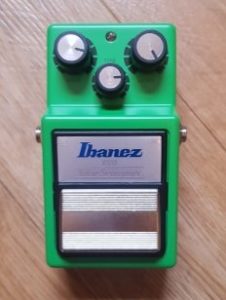
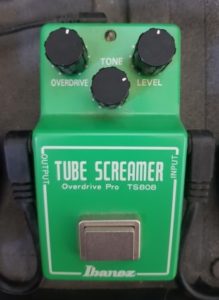
Fuzz
Fuzz pedals are another gain-type pedal, similar to overdrive, but they offer a different kind of effect.
Where overdrive pedals give you more grit and saturation, fuzz makes your tone sound woollier and well, fuzzy! They’re a more aggressive sort of effect that sounds a lot more artificial.
Why is it important?
Fuzz pedals are great for blues players that want to go for a more distorted tone, that sounds a bit more unique rather than just gritty.
Getting this wooly, fuzzy kind of tone can only be achieved with an actual fuzz pedal, so if that’s the kind of sound you need for your blues playing, then it’s pretty essential.
How should you use it?
Fuzz pedals are best used early on in the pedal chain. In most instances, you’ll get the best effect when you use a fuzz pedal either first, or after a tuner pedal if you have one.
You’ll usually get similar controls on a fuzz pedal as you do on an overdrive pedal. Again, you’ll normally get a level control, which allows you to adjust the volume, and a tone control that allows you to make the tone warmer or sharper.
There will also be another control, usually called either fuzz, sustain or output, which allows you to adjust the amount of fuzz.
What is the best fuzz pedal?
There are plenty of great fuzz pedals out there, but one of the most highly regarded is the Electric Harmonix Big Muff. It was famously used by Jimi Hendrix, and it’s been used by loads of professional guitarists since.
You’ll get all the basic controls you need like volume, sustain and tone. It’s also quite reasonably priced on Guitar Center.
Reverb
Reverb pedals have a huge impact on the overall tone of your electric guitar. Reverb occurs naturally all the, when sound waves reflect off surfaces, so think about the kind of echo effect you get if you were to shout in a huge, empty hall.
Reverb pedals are used to emulate this kind of effect, which gives your tone more depth and presence.
Why is it important?
Reverb pedals are useful for pretty much every different style of guitar playing, including blues. They give your tone more presence, and make it sound livelier and fuller. Adding reverb is one of the simplest ways to improve the overall tone of your electric guitar.
How should you use it?
You can use reverb pretty much all the time, at a low level in order to give your tone this added presence and depth. There are several types of reverb effect, including room, hall, chamber, plate and spring. Some pedals have several modes which allow you to adjust the type of reverb effect.
There are normally three controls on most reverb pedals.
The first, is called decay, and it refers to how long the reverb effect will last. The second, is attack, which refers to how quickly the reverb effect kicks in after you play the original note. The third, is usually called mix or level, and it refers to the balance between the volume of your guitar’s natural tone, and the reverb effect.
Reverb pedals work best at the end of the guitar chain. They’re a time-based effect, which causes an echo. If you put this any earlier on in your chain (closer to the guitar), things can start to sound pretty messy.
what is the best reverb pedal?
The Boss RV reverb pedal is a great option to go for if you want this kind of effect. It’s versatile and easy to use most importantly. But it’s also a really well-made pedal in terms of the build quality. It’s sturdy and solid, so you’ll have no problems if you want to take it gigging with you.
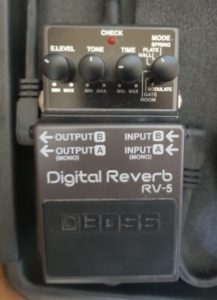
Delay
Delay is another type of effect that most guitar players will use at some point. Delay pedals are another type of time-related, or echo, effect, similar to reverb, however there is a difference between the two. Delay pedals take a note or chord, and then play it back repeatedly.
Why is it important?
Delay pedals can be used to add depth to your tone, like reverb pedals can, or they can add a specific kind of effect which is really useful for soloing. They’re a basic effect but, there are tonnes of different ways to use delay pedals for blues playing.
How should you use it?
Delay effects are often best used sparingly, and for specific situations usually when playing lead guitar or soloing. There are four types of delay, that are usually found on most effects pedals.
- Doubling: sounds very natural and sharp.
- Slapback: a short, quick style of delay.
- Long delay: this sounds the most obvious.
- Ping-pong: this adds an interesting type of delay that bounces from one direction to the next.
On most delay pedals you can control at least three parameters.
The first one, is time, this refers to the length of time between the sound of the original note played on your guitar, and the repeated note. The second, is feedback, this refers to the number of repeats you get when you switch the delay pedal. Finally, there is normally a level control, which refers to the volume of the delay effect.
In terms of the pedal chain order, delay pedals should go at the end of your chain (closer to the amp). This is true, unless you have a reverb pedal, in this case your order should be guitar > delay > reverb > amplifier.
what is the best delay pedal?
The Boss DD-7 Digital Delay Pedal is a solid option in this category. Like with all Boss pedals, they’re built to last and they look great on every pedal board. You’ll get a high quality delay function and plenty control over the parameters like the volume, number of repeats etc.
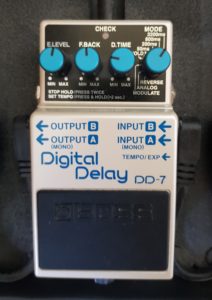
Organising your new pedalboard? Check out my ultimate guide to designing a pedalboard including all the equipment you need and a step by step formula to getting set up in a pain-free way.
More Useful Pedals for Blues
So we’ve been through some of the most important pedals for blues guitar. But that’s not where this article ends. I thought it’d be a good idea to talk you through some other really great pedal types, and why they’ll be really useful if you want to play blues guitar.
Generally, I’d say that you should go ahead and get the other pedals first, but these are great if you want to add to your collection, or if you already have them and aren’t sure how to use them for blues. So here’s the list.
More useful pedals for blues guitar
- Compression
- Wah
- Boost
- Equaliser
Compression
Compression pedals have been around for a really long time, and although they aren’t as glorified as overdrive, reverb etc., they’re definitely as useful. So what do they actually do?
Compression pedals even out the sound of your electric guitar, by decreasing the volume when you pluck a string too aggressively. They’re super useful if you want your tone to sound more polished and professional.
Take a look at this ultimate guide to compressor pedals that I’ve written to learn more about how they work.
Why is it important?
If you want to increase the sustain of your electric guitar tone, and make it sound smoother, more polished, and generally nicer to listen to, then you should definitely check out compression pedals. They’re not just good for blues, but pretty much every guitarist out there will benefit from a compression pedal, that’s why they’re found on most pro player’s pedal boards.
How should you use it?
Generally, compression pedals work best when they’re placed at the start of the pedal chain. This way you can compress the signal coming directly from your guitar, to even out any peaks in volume caused by inconsistent picking pressure.
Compression pedals are useful for both lead and rhythm sections, so I tend to have mine on constantly to give me a smoother tone and better sustain.
There are several controls you can adjust on most compressor pedals. The first is the threshold control (sometimes called level). This refers to the volume at which the compressor will start to actually compress the signal.
Another control you’ll often see, is called ratio or limiter. The ratio works by affecting how much the volume is decrease by the compressor.
For example, you can have a 5:1 ratio. This means if the signal is 5dB above the threshold, then the compression pedal will allow the volume to be 1dB. Hence, it reduces the signal by 4dB. The higher the ratio, the more the volume is decreased.
There’s also usually an attack and release control. The higher the attack control, the faster the compression pedal will kick in. The release control affects how long the note is compressed for.
What’s the best compression pedal?
The Keeley Compressor pedal is the best one I have tried. It sounds very professional, and gives you loads of control over your sound as you can adjust the sustain, level, blend and tone. If you don’t want to spend as much though, then check out the Boss CS-3. You’ll still get all the main controls in a robust and durable design
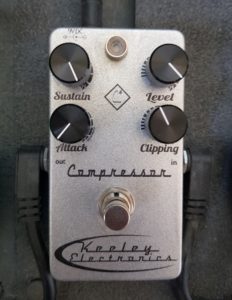
Wah Pedal
Wah pedals aren’t specifically designed for blues guitar, but they are a really useful effect to have on your pedal board. They’re a little different to most pedal effects, and the sound is truly unique.
It’s pretty hard to describe, but think about Jimi Hendrix’s tone, particularly in the song Voodoo Child, that’s what a wah pedal sounds like.
Why is it important?
Like I said before, wah pedals aren’t essential for blues guitar, but they are great if you’re looking for a very specific effect on your tone. If you’re an adventurous player, looking to dial in a signature tone, then definitely give this pedal type a try in the store, and see if it works well for you.
How should you use it?
Wah pedals work best in the pedal chain if you place them before any distortion, fuzz or overdrive pedals. This tends to give you the best effect. However, you should definitely try experimenting with it later in the chain, as you may prefer this more dramatic kind of sound you’ll achieve.
Wah pedals work a little differently than the other pedals we’ve discussed. Instead of having an on/off switch, and a few adjustable controls, you’ll instead get a pedal that basically looks like the type you get in a car.
You then use the pedal by pressing down on it. The more you press, the more dramatic the wah-effect will be. If you only want it to be subtle, you simply don’t put as much pressure on it. They’re super easy to use because they have a very intuitive design.
What is the best wah pedal?
One of the most iconic wah pedals out there, is the Jim Dunlop Cry Baby. It’s not only one of the most popular wah-pedals, but one of the most popular effects pedals full stop. There are a few different types which you can check out on Guitar Center:
Boost
Next on the list, is the boost pedal. This is super useful if you play both rhythm and lead guitar sections in a song, and you need a way to smoothly transition between them.
Boost pedals can give you a clean boost which means you only get a volume increase, or you can use them to get a dirty boost, which means you’ll get an increase in both volume and gain.
Why is it important?
Boost pedals are pretty essential if you need to easily transition between rhythm and lead guitar sections. Simply activating a boost pedal is one of the quickest and easiest ways to give your tone that extra kick when you need it.
How should you use it?
Boost pedals normally come with three controls. The first, is a level or volume control, which can be adjusted according to how much of an increase in volume you need.
The second, is usually called gain, this will give you an increase in sustain and distortion. You can turn it up high to give you a dirty boost effect, or have it low so you get a cleaner boost effect.
The final control is usually a tone control, which can be adjusted to make your tone warmer or brighter.
Normally, boost pedals work best when you put them after any gain pedals (distortion, overdrive, fuzz), modulation pedals (chorus, flanger, phaser), but before any time-related effects like delay or reverb,
What is the best boost pedal?
The XOTIC AC Booster Pedal is a great option if you are a lead guitarist. You get plenty of control over your tone with specific knobs for gain, treble and bass, as well as volume of course. This makes it a great option for both clean and dirty boosting.
Equaliser
The final pedal type on this list, is the equaliser pedal, otherwise known as an EQ pedal. This allows you to adjust the bass, mids and treble frequencies. This is great if you feel limited by the tone controls on your amplifier or guitar.
why is it important?
If you want a very specific kind of tone, then you’ll really benefit from the added versatility that an EQ pedal gives you.
Having the ability to adjust the bass, treble and mids, allows you to give your tone more or less warmth, depth and clarity. It’s great for switching between songs or rhythm and lead sections, without having to mess about with your amplifier.
How should you use it?
You can either choose to use this effect all the time, or you can use it in specific situations to change the tone of your electric guitar.
EQ pedals usually work best if you place them after your distortion and overdrive pedals, but before modulation effects (chorus, flanger, phaser) and time-related effects (reverb and delay).
What is the best EQ pedal?
The Boss GE-7 is a great EQ pedal option. It may look at little bit complicated at first, but if you spend the time to get to know it, it’ll be your best friend. You get 7 bands of EQ which gives you a boost of 15dB in whichever band you choose.
Guitar Center have a huge range of effects pedals at great prices so make sure you check them out if you’re in the market for one. Here’s a link to take you directly to Guitar Center’s effects pedal range so you can check for current deals.
More Frequently Asked Questions
If you still need some more answers about effects pedals for blues, then don’t worry. Here are the answers to some of the most frequently asked questions about guitar pedals.
do I need effects pedals?
This is a big question. It depends on a few different things, like what tone you want, what songs you’re playing, and what guitar and amplifier you’re using. Some blues players don’t use any pedals at all, and that’s fine. It’s all personal preference. Check out the post below if you need some more help figuring out if you need pedals or not.
how do i connect pedals to my guitar and amplifier?
Connecting pedals to your guitar and amplifier is actually pretty simple. All you need is an additional cable, the same type you use to connect your guitar and amp.
Just plug one cable from your guitar, to the input on your pedal. Then plug the other cable to your amp from the output on your pedal. The only other thing you’ll need, is a power source for your pedal. Check out this post to find out exactly what you need and how to do this.
what is the best pedal chain order?
Check out my article on the best pedal chain order here to learn everything you need to know about setting up your chain.
what is a pedal board?
If you’re new to pedals, then you may not really be sure what a pedal board is, and if it’s essential or not. Pedal boards are great if you own a few different pedals. They allow you to keep them all neat, tidy and organised, and some pedal boards have a power supply built-in as well.
They aren’t essential, but they are really useful, if either you often need to take your pedals to gigs, or you want to keep everything neat. Here’s an example below.

Organising your new pedalboard? Check out my ultimate guide to designing a pedalboard including all the equipment you need and a step by step formula to getting set up in a pain-free way.
So there you go! That’s the ultimate guide to guitar effects pedals for rock music! I hope you’ve found this article helpful, thanks for reading. Here are some other posts you might find useful:
